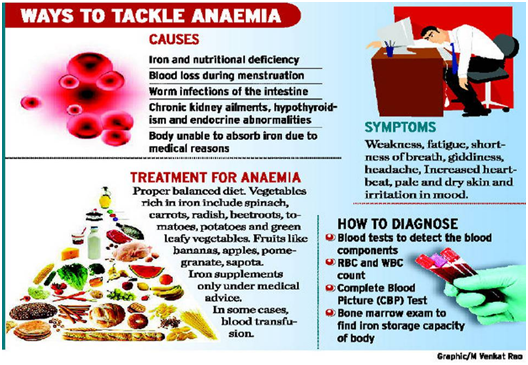

Study says anaemia may contribute to the spread of dengue.
Context
Study says anaemia may contribute to the spread of dengue.
About
What is Anaemia?
- Anaemia is a condition in which the number of red blood cells or their oxygen-carrying capacity is insufficient to meet physiologic needs, which vary by age, sex, altitude, smoking, and pregnancy status.
- According to the World Health Organization (WHO), anaemia among women is defined as a haemoglobin concentration of <120 g/L for non-pregnant women aged 15 years and above, and a haemoglobin concentration of <110-g/L for pregnant women.
- Iron deficiency is thought to be the most common cause of anaemia globally, although other conditions, such as folate, vitamin B12 and vitamin A deficiencies, chronic inflammation, parasitic infections, and inherited disorders can all cause anaemia.
- In its severe form, it is associated with fatigue, weakness, dizziness and drowsiness. Pregnant women and children are particularly vulnerable.
What is the relation between anaemia and the spread of dengue?
- Mosquitoes are more likely to acquire the dengue virus when they feed on blood with low levels of iron.
- Cells in a mosquito's gut take up iron in the blood and use it to produce reactive oxygen. The reactive oxygen kills the dengue virus.
- Supplementing people's diets with iron in places where both iron deficiency anaemia and dengue fever are a problem could potentially limit transmission of the disease, but there are many risks.
Global burden of Anaemia:
- Globally, anaemia affects 1.62 billion people, which corresponds to 24.8% of the population. The population group with the greatest number of individuals affected is pregnant women (41.8%). In women, anaemia may become the underlying cause of maternal mortality and perinatal mortality.
- Nine out of ten anaemia sufferers live in developing countries, about 2 billion people suffer from anaemia and an even larger number of people present iron deficiency.
- WHO has estimated that prevalence of anaemia in developed and developing countries in pregnant women is 14 per cent in developed and 51 per cent in developing countries and 65-75 percent in India alone.
- Prevalence of anaemia in South Asian countries is among the highest in the world. It is estimated that about half of the global maternal deaths due to anaemia occur in South Asian countries and India alone contributes to 50% of global maternal deaths and about 80 per cent of the maternal deaths due to anaemia in South Asia.
Anaemia burden in India:
- According to National Family Health Survey (NFHS)–IV (2015-16), the prevalence of anaemia among women aged 15 to 49 years is 53% and among adolescent girls aged 15-19 years is 54%.
Why there is still such high prevalence of anaemia even within the developed markets?
- Poor eating habits (not eating enough fruits, vitamin C, and legumes such as and beans and peas) and lack of access to healthcare are the main causes for such a high prevalence of anaemia among women.
- Iron supplementation programs have not been successful in decreasing anaemia in India.
- Anaemia is difficult to diagnose, as the symptoms are non-specific in the mild early stages. Studies suggest that more than 50% of people with anaemia are not aware that they have the condition.
- High prevalence of conditions that can cause anaemia, such as Chronic Kidney Diseases (CKD): In people with CKD, anaemia arises due to kidney damage lowering the production of hormones that direct haemoglobin production.



